
Origin
The History of Mitsubishi Pioneered by Four Presidents
The origin of Mitsubishi goes back to 1870 when the founder, Yataro Iwasaki, started a shipping firm with three aging steamships. Yataro's brother, son and nephew expanded the business into various fields during their respective terms as president and set the foundation of the Mitsubishi companies. After WWII, the original Mitsubishi organization was disbanded to become the independent companies they are today.
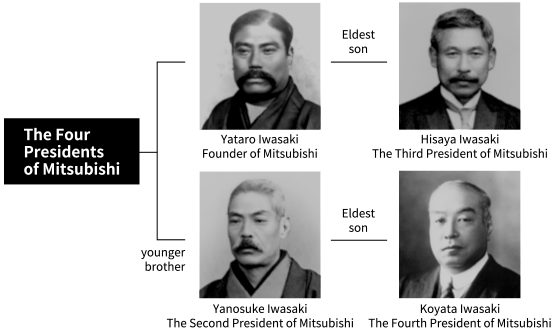
Founder of Mitsubishi(1870-1885)
Yataro Iwasaki
An entrepreneur who
demonstrated
strong leadership
Establishing Mitsubishi with shipping as its core business in a time of turbulence
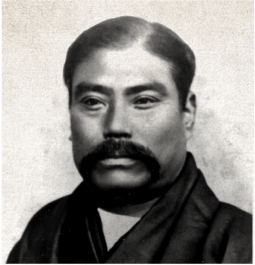
1830 - 1880
A visionary and formidable entrepreneur
When we look back on history, there have always been new businesses arising during times of political and social change.
The final days of the Tokugawa Shogunateand the Meiji Restoration that followed in 1868 was one such period, and it was Yataro Iwasaki who had the knowledge and the vision to see a new era coming, and with it the need for strong and organized international commerce.
Yataro Iwasaki was born in 1835 and as a young man worked for the Tosa Clan, one of the most powerful merchant clans of the time. Exporters of specialty goods such as camphor and dried bonito and importers of warships and weapons, the clan initially conducted its business operations in Nagasaki, the only sea port authorized to conduct trade between Japan and the outside world. Due to Yataro’s strong leadership and business savvy, the clan’s business operations were eventually moved to Osaka. When the Meiji government set out a policy of banning the system of clan-led businesses, powerful members of the Tosa Clan, Shojiro Goto and Taisuke Itagaki, established Tsukumo Shokai, Mitsubishi’s predecessor, in 1870 to take over the clan’s shipping business. In 1873, the new government enforced the abolition and in the turbulent period of change that followed, Yataro took over the management and formed Mitsubishi Shokai, making him one of the most successful and powerful businessmen in the new Japan.
Origins of the Famous Emblem
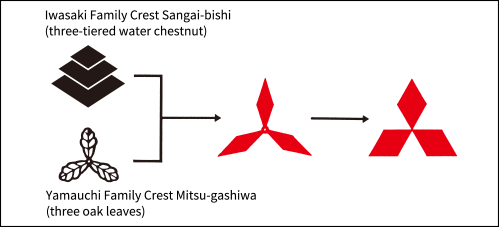
The name “Mitsubishi” refers to the three-diamond emblem.“Mitsubishi” is a combination of the words “mitsu” and “bishi.”
Close▲
- 1835
- Yataro Iwasaki, founder of Mitsubishi, was born in Inokuchi Village in Tosa.
The early years of Yataro Iwasaki
Very early in his life, Yataro understood the importance of a good education. Studying under a noted scholar of the time, Neiho Okamoto, the boy received an education only the very privileged of his day could have access to, all the more remarkable because of his roots in a small village in Tosa, Japan. Moving to Tokyo under the tutelage of Zosai Okunomiya, a prominent Confucian scholar of the time, Yataro was destined for greatness.
Close▲
- 1853
- Matthew C. Perry, the Commodore of the U.S. Navy, arrived at Uraga.
- 1854
- Yataro had an opportunity to go to Edo as an assistant to Zosai Okunomiya, a Confucian scholar, who was on an assignment to Edo.
- 1859
- Thomas B. Glover came to Japan to manage newly established Nagasaki office of a British trading house.
- 1867
- The Meiji Restoration(The Tokugawa Shogunate returns political power to the Emperor Meiji)
Mitsubishi’s transformation into a shipping company
In 1867, Yataro was appointed manager of the trading operations of the Tosa Clan’s business interests in Nagasaki. As Japan continued to open to Western trade, ports in Osaka, Kobe and Yokohama emerged as centers of commerce, replacing Nagasaki, which had long been Japan’s only officially designated open port. In 1869, Yataro was assigned to Osaka and rose to become manager of the clan’s Osaka operations. In 1870, Tsukumo Shokai was established with three steamships chartered from the Tosa Clan, and three years later changed its name to Mitsubishi Shokai. The following year its headquarters were moved to Tokyo and the company was renamed Mitsubishi Jokisen Kaisha.
Under an exclusive contract from the government, Mitsubishi provided the ships that carried Japanese troops to Taiwan in 1874, and later to Satsuma when the Southwestern Rebellion broke out in 1877. This business earned Mitsubishi the trust of Japan’s government and the financial rewards of this business relationship solidified the financial base for the company for the future. During this period, Mitsubishi owned 61 ships, or 73% of the gross tonnage of Japan’s steamship fleet.
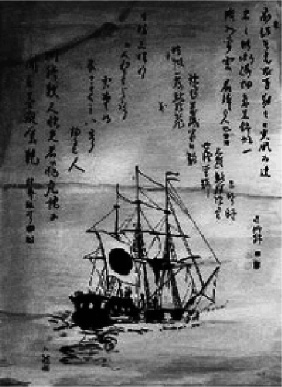
A steamship of the Tosa Clan
(Library of Kochi City)
Close▲
- 1870
- Tsukumo Shokai is launched to take over the Tosa Clan’s shipping business.
 A steamship of the Tosa Clan
A steamship of the Tosa Clan
(Library of Kochi City)
- 1872
- Tsukumo Shokai changed its name to Mitsukawa Shokai.
The first steam train operated between Shimbashi and Yokohama.
Origins of the Famous Emblem The name “Mitsubishi” refers to the three-diamond emblem.
The name “Mitsubishi” refers to the three-diamond emblem.
“Mitsubishi” is a combination of the words “mitsu” and “bishi.” - ▶︎Read more
- 1873
- Mitsukawa Shokai changed its name to Mitsubishi Shokai.
Mitsubishi Shokai purchased the Yoshioka Mine in Okayama.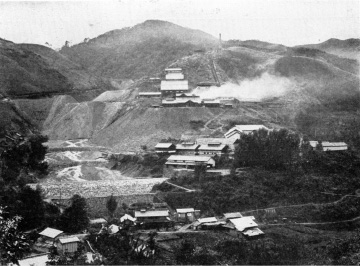 The Yoshioka Mine
The Yoshioka Mine
The remarkable contributions of Yataro Iwasaki
Established in 1873, Mitsubishi Shokai originally conducted business primarily as a shipping and trading company, but Yataro skillfully moved the company in the direction of diversification, and into mining early in its history. With the purchase of the Yoshioka Mine, in Okayama, the company introduced modern technology that resulted in the discovery of previously hidden rich veins of copper, transforming the mine’s dwindling production to one of Japan’s highest producing copper mines.
This remarkably skillful business visionary further moved Mitsubishi into other businesses that included shipping documentation services, warehousing and financial services. In 1881, the company purchased an extremely unprofitable coal mine owned by Shojiro Goto, in Nagasaki, and with the introduction of new mining technology developed by Mitsubishi, the business became highly profitable. In 1884, Mitsubishi leased the Nagasaki Shipyard and later purchased the facility from the Japanese government, heralding an era of growth that made Mitsubishi one of the world’s leading shipbuilding companies.

The Yoshioka Mine
Close▲
- 1874
- The company changed its name to Mitsubishi Jokisen Kaisha and its headquarters were moved to Tokyo.
- 1875
- Mitsubishi Jokisen Kaisha became Yubin Kisen Mitsubishi Kaisha.
- 1879
- Tokio Marine Insurance Company was established as the first non-life insurance company in Japan.
The Second President of Mitsubishi(1885-1894)
Yanosuke Iwasaki
Consistent dutifulness
as seen in
his honest behavior
Paving the way for Mitsubishi while continuing his brother’s legacy
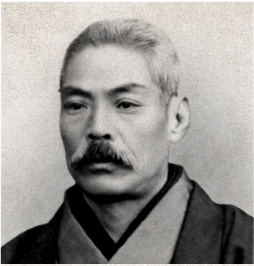
1880 - 1896
A transition of power and leadership
“I am here to announce that I will take over leadership of Mitsubishi and do my best to expand our shipping business. I will strive to fulfill the long-cherished desire of my deceased brother with his same indomitable spirit.” With these words, Yanosuke Iwasaki, the younger brother of the founder Yataro Iwasaki, became Mitsubishi’s second president in 1885. Sixteen years junior to his brother, Yanosuke previously spent a brief period in the U.S., where he studied and learned about American culture and customs, an experience that would influence his actions throughout his lifetime. His international education, however, was cut short by his father’s untimely death in 1873 and the young Iwasaki returned to Japan. Later he stepped into his brother’s role as the administrative leader and became the driving force of a new and prosperous Japanese company.
Close▲
- 1880
- Yataro founded Mitsubishi Exchange House.
- 1881
- Mitsubishi purchased the Takashima Coal Mine in Nagasaki. Meiji Life was established as the first modern life insurance company in Japan.
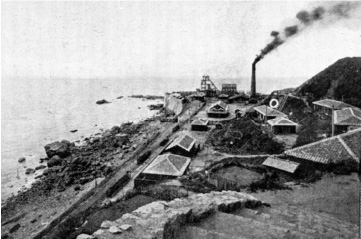 The Takashima Coal Mine
The Takashima Coal Mine
A strategy for growth encompassing the concept
of diversification
One of the achievements for which founder Yataro Iwasaki deserves credit is his efforts to diversify the company’s holdings early in its history. Yanosuke played a major part in one of these expansions, namely the purchase of the Takashima Coal Mine, in 1881. The previous owner, Shojiro Goto, had acquired the mine from the Japanese government, and owing to poor management and a lack of expertise in the mining business, ran the company into disarray. Yanosuke Iwasaki persuaded Yataro to purchase the mine through his comprehensive assessment of its estimated reserves and business potential. Under new management, the mine later emerged as a profitable enterprise, as new mining technology was introduced. Through his early experiences researching the mining business for his older brother, Yanosuke became Mitsubishi’s expert in mining, later acquiring mines for the company in Chikuho and Karatsu as well as in Nagasaki.

The Takashima Coal Mine
Close▲
Mitsubishi’s acquisition of property in Tokyo’s
Marunouchi district
During Japan’s Edo period, some clans had mansions in the Marunouchi district adjacent to Edo Castle. Following the Meiji Restoration, the area became government property and was transformed into military barracks, drill fields and other military facilities for the Imperial Palace Guards.
Later, the government attempted to raise money for the army’s planned construction of a brick barracks at Azabu by selling the land lots at Marunouchi—an area of about 413,000 m2. When calling for bids among the predominant zaibatsu of the time, tender prices were found to be far smaller than anticipated by the government.
Therefore, in order for the government to rebuild its military installations, then Finance Minister Masayoshi Matsukata, facing insufficient government funding for the effort, asked Yanosuke to purchase the property. The young Iwasaki was inspired by his youthful memory of Manhattan, and considered that Japan would need an office district like that of London to support its modernization. With Mitsubishi’s purchase of Marunouchi, yet another era for the growing company had begun.
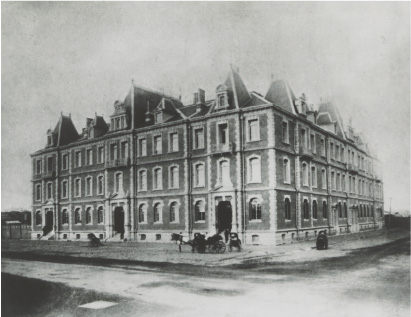
Mitsubishi Ichigokan
Close▲
- 1884
- Mitsubishi leased the Nagasaki Shipbuilding Yard from the government.
- 1885
- Yanosuke took office as the 2nd President on the death of Yataro.
- 1886
- The company changed its name to Mitsubishi Sha.
Hisaya entered the University of Pennsylvania.
- 1889
- The Imperial Japanese Constitution was issued.
- 1890
- Mitsubishi bought about 363 thousand m2 of land in Marunouchi and Kanda districts at the request of the government.
Honoring duty and integrity for the future of
Mitsubishi
With the enactment of Japan’s commercial code in 1893, Mitsubishi was restructured and renamed Mitsubishi Goshi Kaisha. Fulfilling a promise to his older brother, Mitsubishi’s founder, Yanosuke then stepped down as president in favor of his nephew, Hisaya, turning over the reins of power and leadership to the next generation. He continued to be involved in the activities of the growing company in a supervisory role and continued to maintain an instrumental role in the management of the company. At this time in Mitsubishi’s history, Yanosuke was 42 years old, and Hisaya only 28.
Yanosuke went on to become Governor of The Bank of Japan three years after retiring from Mitsubishi, an appointment he received from then Prime Minister Masayoshi Matsukata. In 1896, as the Governor, he established the gold standard system and a collaborative framework with Yokohama Shokin Bank, Ltd., one of the predecessors of today’s MUFG Bank, Ltd.
Yanosuke established the Seikado Bunko Library with books that he had received from his former teacher, scholar Yasutsugu Shigeno. Yanosuke was an avid collector of Oriental art and cultural artifacts during the Meiji Restoration, a time when things Oriental were being cast aside for anything Western. A true visionary, Yanosuke understood the value in preserving the heritage of his culture and country. During his lifetime, Koyata Iwasaki also continued to collect items for the library, continuing his father’s legacy.
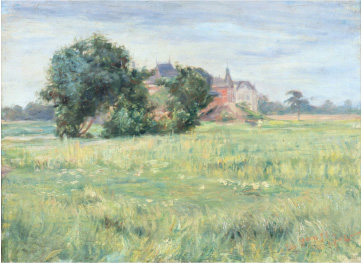
“Mitsubishigahara” Marunouchi circa 1890
Close▲
- 1894
- Mitsubishi Goshi Kaisha was established, and Hisaya took office as the 3rd President.
Mitsubishi Ichigokan was completed in Marunouchi.
 Mitsubishi Ichigokan
Mitsubishi Ichigokan
- 1896
- Yanosuke took office as the 4th Governor of The Bank of Japan.
The Third President of Mitsubishi(1894-1916)
Hisaya Iwasaki
Modern business sense
and
management skills
Establishing an organizational structure based on a U.S. style management
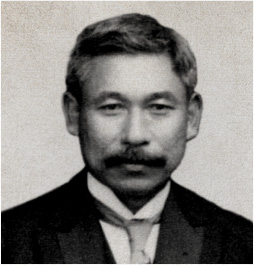
1890 - 1916
Transforming Mitsubishi into a modern enterprise
In his early days, in 1886, Hisaya Iwasaki studied at the Wharton School of the University of Pennsylvania in the U.S. This was the period when great capitalists such as Rockefeller and Carnegie began to emerge in America to build businesses in oil, coal and steel. Hisaya experienced this big wave of American business firsthand.
His exposure to American education had a profound impact on the young Iwasaki’s life and upon his return to Japan, he built himself a Western-style house designed by a British architect, Josiah Conder, and surrounded it with gardens reminiscent of the American countryside. Today, the Tokyo Metropolitan Government owns the house and gardens, so the public may now enjoy this splendid representation of Western-style living.
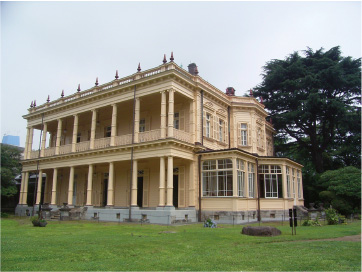
Hisaya’s former residence (currently Kyu-Iwasaki-tei Teien)
Close▲
- 1894
- Mitsubishi Goshi Kaisha was established, and Hisaya took office as the 3rd President.
Mitsubishi Ichigokan was completed in Marunouchi.

Mitsubishi Ichigokan
- 1895
- The Nagasaki Shipyard received an order to build a passenger-cargo vessel of the 6,000-ton class for the first time. Banking Division was established in Mitsubishi Goshi Kaisha.
Transforming Mitsubishi into a leading shipbuilder
In 1895, Nippon Yusen built one of six passenger-cargo vessels (6,000-ton class) for a European line at the Nagasaki Shipyard. Until this time, only British companies had the shipbuilding capabilities to construct this size of commercial ship. The ship, Hitachi Maru, was the first of its size for the Nagasaki Shipyard, and the experience gained from the construction of this vessel set the stage for a growing number of orders for larger vessels, including an order for the 13,000-ton class luxury liner, TENYO MARU, and many subsequent orders for large-scale battleships.
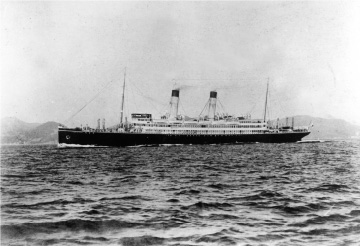
TENYO MARU, a 13,402-ton liner, completed in 1908.
Close▲
- 1899
- The Iwasaki family acquired Koiwai Farm.
- 1902
- The Anglo-Japanese Alliance was concluded.
- 1904
- The Russo-Japanese War broke out.
- 1905
- Kobe Shipyard was founded.
Creating a modern corporate management system
In 1908, Hisaya introduced into Mitsubishi a management system very much like today’s system of operational divisions. The aim of this change was to give each division responsibilities and cost consciousness in order to further expand the company’s businesses. Mitsubishi Goshi Kaisha consisted of the divisions of banking, shipbuilding, administration, mining, sales, and real estate, to which direct management authority was then transferred. This move was a decisive and strategic gain for the growing Mitsubishi, increasing both efficiency and profitability as a corporate enterprise. The introduction of the division system was the first step in Mitsubishi’s transformation from a one-man rule company to a truly modern corporate structure, equipped to meet the challenges of a rapidly changing and increasingly international business environment.
Close▲
- 1914
- WWI broke out.
- 1916
- Hisaya resigned, and Koyata took office as the 4th President.
Major contributions even in retirement
In 1916, while Japan prospered during the war boom of WWI, Hisaya stepped down as president and entrusted the reigns of leadership to his cousin Koyata Iwasaki. At the time Hisaya was 50 years old, and he felt he could confidently entrust the business to his successor at such a time of robust economic growth. It was a truly selfless decision, and having passed over the reins of power, Hisaya refrained from interfering in the business of Mitsubishi Goshi Kaisha.
Following his retirement, Hisaya Iwasaki worked to contribute to society, while also being involved in agriculture and cattle raising at Koiwai Farm. In 1924, he established The Toyo Bunko Foundation, which has become one of the world’s leading centers for Asian studies. Currently, the facility houses about 950 thousand documents and many artifacts for public viewing.
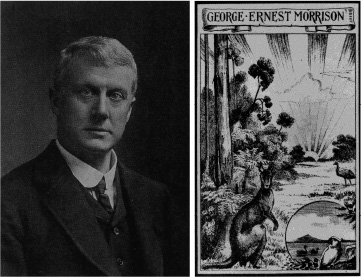
George Ernest Morrison and the ex libris of his collection. After being purchased by Hisaya Iwasaki, the Morrison Collection provided the foundation for the Toyo Bunko.
Close▲
The Fourth President of Mitsubishi(1916-1945)
Koyata Iwasaki
Sophisticated foresight
and
highly globalized sensibilities
Protecting Mitsubishi from wartime turmoil with his vision for the future
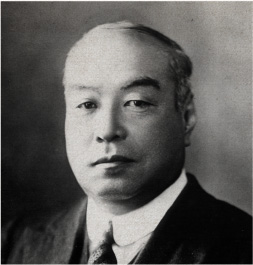
1910 - 1946
A voice of reason during a time of despair
On October 20, 1945, only two months following Japan’s surrender to the Allied Forces, Japan was dealt a further economic hardship when the Allied Command ordered the disbanding of all zaibatsu, the nation’s industrial and financial business conglomerates. The order was given because Allied Command considered the military and the zaibatsu to have been ultimately responsible for driving Japan into the war, and sought to break up economic forces that exercised totalitarian monopolistic power. The hard work of many went unrecognized at the time of the dissolution of these zaibatsu corporations, and among them, the work of Yataro Iwasaki and the Mitsubishi Group. Koyata Iwasaki, the founder’s nephew and fourth president of Mitsubishi, was an outspoken advocate, asserting publicly that Mitsubishi was a friend to many business partners around the world and that it had never engaged in dishonorable business practices.
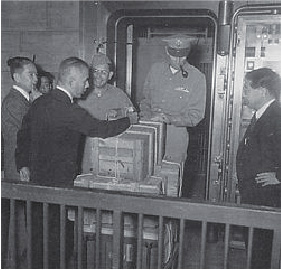
Seizure of zaibatsu families’ assets (“Showa History Vol. 13: Ruin and Lack” published by Mainichi Newspaper Company)
Close▲
A champion of internationalism and
goodwill in a time of discord
Koyata Iwasaki was the most international spirited Japanese businessperson of his era, having completed his formal education at the famed University of Cambridge in England. Despite the spirit of internationalism and social justice he engendered, at the outbreak of hostilities following Japan’s attack on Pearl Harbor, Koyata Iwasaki stated at a speech given to the assembled top executives of each Mitsubishi Group company: “Now our nation has come to a decision. And although my personal ideas regarding diplomacy depart from those of the nation, we are all now called upon to follow the order of our Emperor, to be united and to endeavor with all our strength for the nation.” A small voice of reason in a time of turmoil and growing call to arms, Koyata urged the nation to look beyond the current state of affairs, and envision a time when internationalism and peace would prevail. A forward thinker, Koyata Iwasaki spoke of the day when people everywhere could work towards the global good. He was a man dedicated to the ideas of international understanding and the globalization of markets, long before the concepts and phrases had entered our modern lexicon. His idea of “corporate responsibility to society” guiding individual and corporate actions, known in Japanese as shoki hoko, would define one of Mitsubishi’s guiding principles for decades to come. It is important to remember, that during the turbulent years of WWII and in its aftermath, the Mitsubishi Group continued its responsible stewardship of its associated British and American business interests in Japan and the region, in this spirit of Koyata’s dedication to internationalism.
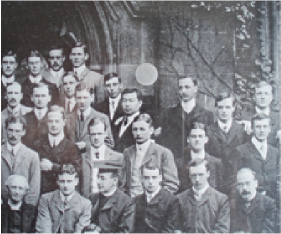
Studying abroad at the University of Cambridge
Close▲
- 1916
- Hisaya resigned, and Koyata took office as the 4th President.
A proponent of cooperation and
accountability in a time of transition
Koyata’s strong conviction that integrity and fairness were the foundation of all business remains a cornerstone of Mitsubishi’s management philosophy today. Amidst the economic depression of the early 20th century, Mitsubishi’s operations were guided by a set of core principles. With the nation hard hit by the difficult economic times, Koyata advocated responsible action and assistance to manufacturers, producers and the public Mitsubishi served. Placing an unwavering commitment to quality and fair business practices, Mitsubishi survived and prospered and in many instances took a leadership role in moving the industries in which it conducted business to profitability and sustainable prosperity. In 1934, his ideas became officially accepted as Mitsubishi’s guiding principles, and these principles would lead the company to greatness in the 20th century and beyond.
Close▲
- 1920
- Japan joined the League of Nations.
- 1923
- Original Marunouchi Building was completed.
- 1924
- Hisaya established The Toyo Bunko Foundation.
- 1933
- Japan walked out of the League of Nations.
- 1937
- Mitsubishi Goshi Kaisha was reorganized into a joint-stock company under the new name Kabushiki Kaisha Mitsubishi Sha.
- 1940
- Koyata established Seikado.
- 1941
- The outbreak of the Pacific War.
- 1943
- Mitsubishi Sha was renamed Kabushiki Kaisha Mitsubishi Honsha.
- 1945
- The end of WWII.
- 1946
- Mitsubishi Honsha disbanded.
Development of the Marunouchi district
Tokyo’s Marunouchi district, which had developed as a focal area for the army of the new government following the Meiji Restoration, gradually transformed itself into the nation’s nerve center for business activities. In 1894, the first modern office building was constructed in the British red-brick architectural style and in 1914, the country’s landmark Tokyo Station was opened as the transportation hub of the nation.
The early 1920s, saw construction of American-style office buildings for Japan’s growing business center. These were large and could be built relatively quickly. It was at this time that Koyata made the decision to build Mitsubishi’s new building. The former Marunouchi Building was a landmark structure, which opened on February 20, 1923, after being built in record time using new construction technology by a leading New York construction firm. Less than a year after its completion, the Marunouchi Building survived the Great Kanto Earthquake of 1923, which devastated most of the Tokyo skyline. The famous icon facing Tokyo Station was demolished in 1999 as part of a massive redevelopment project for the district. In 2002, a new Marunouchi Building was completed. It has become a familiar landmark in the Marunouchi area.
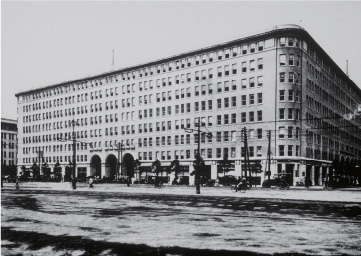
The original Marunouchi Building
Close▲

The original Marunouchi Building
76 Years After the Postwar Reconstruction
The Mitsubishi Group Takes a New Step Forward
1950 - 1970
- 1949
- Fixed exchange rate introduced: $1=¥360
Reestablishing our corporate identity following
the dissolution of the Group
Following the end of WWII, the Allied Forces in Japan demanded the dissolution of the zaibatsu that had held so much power in the prewar period, ending Mitsubishi’s leadership by four generations of the Iwasaki family. In September 1946 the company disbanded its headquarters, and its network of affiliates and subsidiaries were all relaunched as independent companies.
Moreover, GHQ orders strictly prohibited the use of the Mitsubishi trade name or logo, as well as interlocking directorships with affiliated companies. Despite the harsh business environment, the companies shared a common vision and sometimes cooperated with each other to develop their businesses. As part of this, they began holding regular get-together luncheons for the group presidents in 1952, which were named “Mitsuibishi Kinyokai” in 1954.
The San Francisco Peace Treaty came into effect in 1952 and brought about a repeal of the ban on using zaibatsu trade names and logos. With this change, former Mitsubishi Group companies reclaimed the Mitsubishi name.
In 1954, the once-divided Mitsubishi Corporation conducted a series of mergers leading to an overall merger into a single entity.
Close▲
- 1951
- San Francisco Peace Treaty signed
- 1953
- NHK starts TV broadcasts
- 1954
- Mitsubishi Corporation reestablished
- 1956
- Japan leads the world for number of new ships built
Radar facilities atop Mt. Fuji that revolutionized
Japan’s weather forecasting
The 1959 Isewan typhoon caused untold damage and more than 5,000 deaths and missing persons. To quickly detect the location of typhoons approaching mainland Japan, the Japan Meteorological Agency decided to install weather radar to the Mt. Fuji weather station, and Mitsubishi Electric Corporation won the contract for this radar base of the radar equipment. It was extremely a tough task to work at the top of Mt. Fuji and transport materials to the working site, but in August 1964, a radar capable of making observations up to 800 kilometers away was finally completed and its operation started in 1965. The radar continued to play a key role in Japan’s meteorological observations up until 1999. Its results and contributions have been widely recognized, and in March 2000, the Mt. Fuji radar system was recorded on the list of IEEE Milestones in electrical engineering.
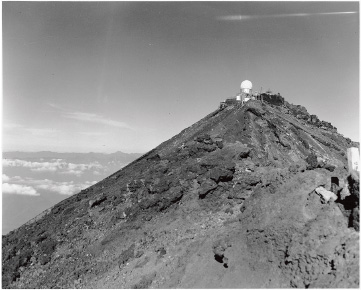
Radar facilities constructed on Mt. Fuji in 1964
Close▲
- 1962
- Kenichi Horie makes first solo sailing voyage across the Pacific
- 1964
- MHI reunited
Mitsubishi Public Affairs Committee founded
Japan’s first bullet train line commences operations
The Tokyo Olympics held
The Tokyo Olympics and the reunification
of the Mitsubishi Group
In 1964, Mitsubishi Heavy Industries, Ltd. (MHI) completed the reunification of its former companies. In September of the same year, the Mitsubishi Public Affairs Committee was established with the mission of increasing the Mitsubishi Group’s involvement in community activities and its contribution to society overall.
The move was also designed to increase public recognition for the Mitsubishi brand and to enhance communication among the growing numbers of companies comprising the Mitsubishi Group.
In October of the same year, the opening of the Tokyo Olympics realized Japan’s long-held desire and allowed the country to demonstrate to the whole world that it had truly recovered.
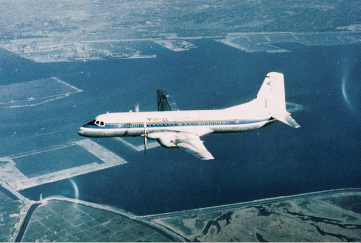
The YS-11, an airliner built by a consortium that included MHI
Close▲

The YS-11, an airliner built by a consortium that included MHI
A new era in corporate responsibility and leadership
During the 1960s, enterprises closely aligned with Mitsubishi began to strengthen their mutual links.
At the same time, Mitsubishi took a positive approach to foreign capital. For example, Mitsubishi Petrochemical Co., Ltd. (currently Mitsubishi Chemical Corporation) was established in 1956 as a joint venture with Shell Group; Mitsubishi Reynolds Aluminum Co., Ltd. (currently Mitsubishi Aluminum Co., Ltd.) was established in 1962 as a joint venture with Reynolds International, Inc.; and Mitsubishi Precision Co., Ltd. was founded in 1962 as a joint venture with Mitsubishi Electric Corporation, Mitsubishi Heavy Industries, Ltd., Mitsubishi Corporation, the Mitsubishi Bank, Ltd., and General Precision Inc.
The rapid growth of the Japanese economy during the 1950s and 60s was due in no small part to the astounding growth in the manufacture of consumer products and the expansion of consumer markets. Following close behind was growth in credit card businesses, of which Mitsubishi was a key player, organizing Diamond Credit Co., Ltd. (currently Mitsubishi UFJ NICOS Co., Ltd.) in 1967.
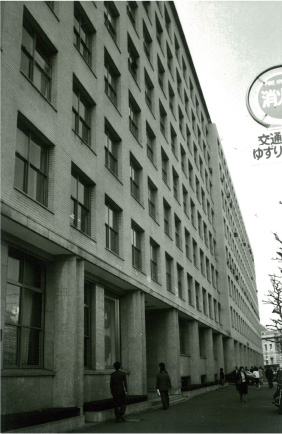
The Tokyo Building of the past, now housing Mitsubishi Electric Corporation
Close▲

The Tokyo Building of the past, now housing Mitsubishi Electric Corporation
- 1970
- Centennial of Mitsubishi’s founding
Creating a New Future After a Century in Business
1970 ~
- 1970
- The Mitsubishi Miraikan (Mitsubishi Pavilion) was opened at the Japan World Exposition in Osaka
Welcoming another century after the Group’s
centennial year
In 1969, the year before the Mitsubishi Group’s 100th anniversary, the Mitsubishi Foundation was established. The Foundation is an active supporter of a wide range of academic research and social welfare programs.
During the occupation of Japan by the Allied Forces following the end of WWII, the zaibatsu were disbanded and their trade names abolished. In the decades of reconstruction following this difficult period in Japanese modern history, Mitsubishi was able to maintain a corporate identity despite its organizational dissolution through the nurturing of its original management principles, embodied in the themes of Corporate Responsibility to Society, Integrity and Fairness, and Global Understanding through Business.
To mark its centennial anniversary, the Group sponsored the Mitsubishi Pavilion at the Japan World Exposition in Osaka in 1970. In subsequent years, Mitsubishi has continued to maintain a high profile in international business and has also participated in other international events, including the ’75 Okinawa International Ocean Expo, the Kobe Portopia ’81 Exposition, the ’85 International Exposition in Tsukuba, the ’90 International Garden and Greenery Exposition in Osaka, and the 2005 World Exposition in Aichi.
Its participation in these international gatherings is a reflection of the Group’s determination to contribute to the promotion of international understanding and a better world for all people.
Close▲
- 1973
- Oil crisis
A slow and steady approach is woven into
Mitsubishi’s DNA
Throughout the years of Japan’s “bubble economy,” primarily during the 1980s and early 1990s, the Mitsubishi Group continued to manage assets following a careful and determined approach to business, reflecting its adherence to the management principles that have guided Mitsubishi’s business affairs for more than a century.
This steadfast approach to business was woven into Mitsubishi’s DNA by President Koyata in the years immediately following WWI, when Japan’s economy had succumbed to a speculative boom fueled by post-war recovery demand. The president sent out a memo urging managers to eschew harmful, empty business practices based on easy speculation and short-term profit, and to foster instead a culture based on a slow but steady approach to management.
Over half a century later during Japan’s bubble economy, Mitsubishi’s core philosophy protected the company from the folly of over-investment in the heat of the boom, allowing the Group to emerge from the bubble’s collapse relatively unscathed with only a few bad debts on its books.
Close▲
- 1985
- First ever win for a Mitsubishi brand car at the Dakar Rally
The Plaza Agreement (yen appreciates against the dollar)
- 1991
- Collapse of Japan’s economic bubble
- 1995
- The Great Hanshin-Awaji Earthquake
Marunouchi—one of the world’s best places for
interactions
Marunouchi has become one of Japan’s leading business centers. Mitsubishi Estate has taken a central role in the redevelopment of the Marunouchi district, including the Otemachi and Yurakucho areas, turning it into a diverse community that represents the best of Japan.
Ever since Mitsubishi Estate announced the rebuilding of the Marunouchi Building in 1995, redevelopment of the area around Tokyo Station has proceeded rapidly. One after the other, buildings were torn down and rebuilt, including the Marunouchi Building in 2002, the Industry Club of Japan and Mitsubishi UFJ Trust and Banking Building in 2003, the Marunouchi My Plaza and the Marunouchi Oazo in 2004, the Tokyo Building in 2005, and the Shin-Marunouchi Building and The Peninsula Tokyo in 2007. These new buildings revitalized the area.
The Marunouchi Park Building and the Mitsubishi Ichigokan were completed in 1894. Following the demolition of the latter, a museum was built on the same site and opened to the public in April 2010. In January 2012, the Marunouchi Eiraku Building was finished, followed by the Otemachi Financial City North Tower and South Tower in October. Next to the Otemachi Financial City Grand Cube, which was completed in 2016, a Japanese inn was invited. In 2017, the Otemachi Park Building was built as the first residential tower featuring serviced apartments in Otemachi. We will focus our efforts on enhancing the functionality of the area as a global business center.
TOKYO TORCH (= Tokyo Station Tokiwabashi Project), which is slated for completion in 2027, will be Japan’s tallest skyscraper, standing at about 390 meters. This will become a new symbol of Tokyo.
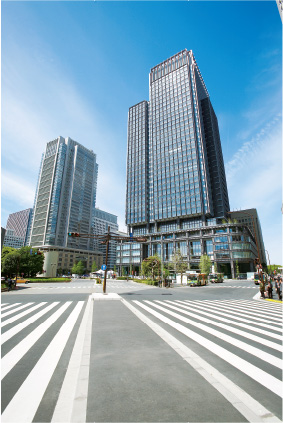
Marunouchi business district
Close▲
- 2002
- Marunouchi Building rebuilt
- 2007
- Shin-Marunouchi Building rebuilt
- 2008
- Kibo was attached to the International Space Station
- 2010
- Sponsored the Japan Pavilion at Expo 2010 Shanghai China
- 2011
- The Great East Japan Earthquake
- 2015
- MRJ’s first flight
- 2016
- Opening of Otemachi Financial City Grand Cube
- 2019
- The era changed from Heisei to Reiwa
H-IIB Launch Vehicle No. 8 carrying HTV8 (KOUNOTORI8) successfully launched
Helping fight climate change by accelerating
decarbonization
Amid the increasing urgency of reducing CO2 emissions, providing clean energy, including electricity and other power sources, which are indispensable for the development of human livelihoods and industries, has become a top global priority. Beginning with power generation systems, Mitsubishi Heavy Industries (MHI) Group has been continuously providing a variety of products and solutions that facilitate both economic development and help reduce environmental impact. In 1984, MHI delivered the first domestic combined cycle power plant, achieving what was then the world’s highest rate of thermal efficiency at over 44%, and radically improving energy efficiency over conventional thermal generation plants. Ever since, we have continued to improve thermal efficiency, contributing to the further reduction of environmental impact.
In the field of nuclear power—a carbon-free energy capable of stable, large-scale supply—MHI has worked to develop new technologies ever since the successful completion of Japan’s first nuclear power plant in 1970. We keep supporting the electric power companies for safety improvement, restart, and maintenance of existing nuclear power plants. Also, MHI aims to establish the nuclear fuel cycle. In addition, we are developing a next-generation reactor that achieves the world’s highest levels in both safety and economic efficiency, and a high temperature gas-cooled reactor as thermal energy for hydrogen production.
We are also engaged in the field of renewable energy sources, such as wind, geothermal and hydropower, none of which emit greenhouse gases.
In order to realize a carbon-free society, carbon capture, utilization and storage has been gaining attention as a solution. Since 1990, we have been developing technology for CO2 capture from combustion flue gas and have been delivering commercial-use CO2 capture plants for numerous chemical plants and power plants. In 2020, we commenced a new pilot project in the UK for CO2 capture from a biomass power plant.
In preparation for the expected coming age of hydrogen, we are also developing a range of hydrogen-utilizing technologies and solutions. In addition to converting natural gas-fired power plants to hydrogen fuel, a high-efficiency power generation system that uses hydrogen—a system combining a solid oxide fuel cell and a micro gas turbine—was introduced in the Marunouchi Building in February 2019. Currently, it enhances energy savings and eco-friendliness.
One of the three principles of Mitsubishi’s Business Management Philosophy, “Corporate Responsibility to Society” has been embodied in the modern ideal of “Striving to enrich society, while contributing towards the preservation of the global environment” and handed down to each Mitsubishi Group company.
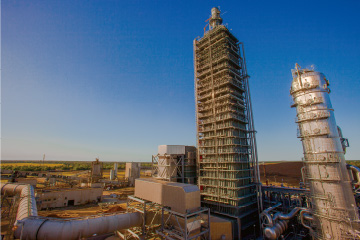
World’s largest post-combustion CO2 capture system
(Houston, Texas, USA)
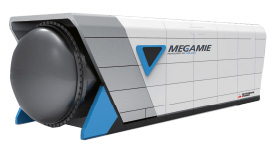
Solid oxide fuel cells (SOFC)
Photo courtesy of Mitsubishi Power
Close▲

World’s largest post-combustion CO2 capture system
(Houston, Texas, USA)

Solid oxide fuel cells (SOFC)
Photo courtesy of Mitsubishi Power